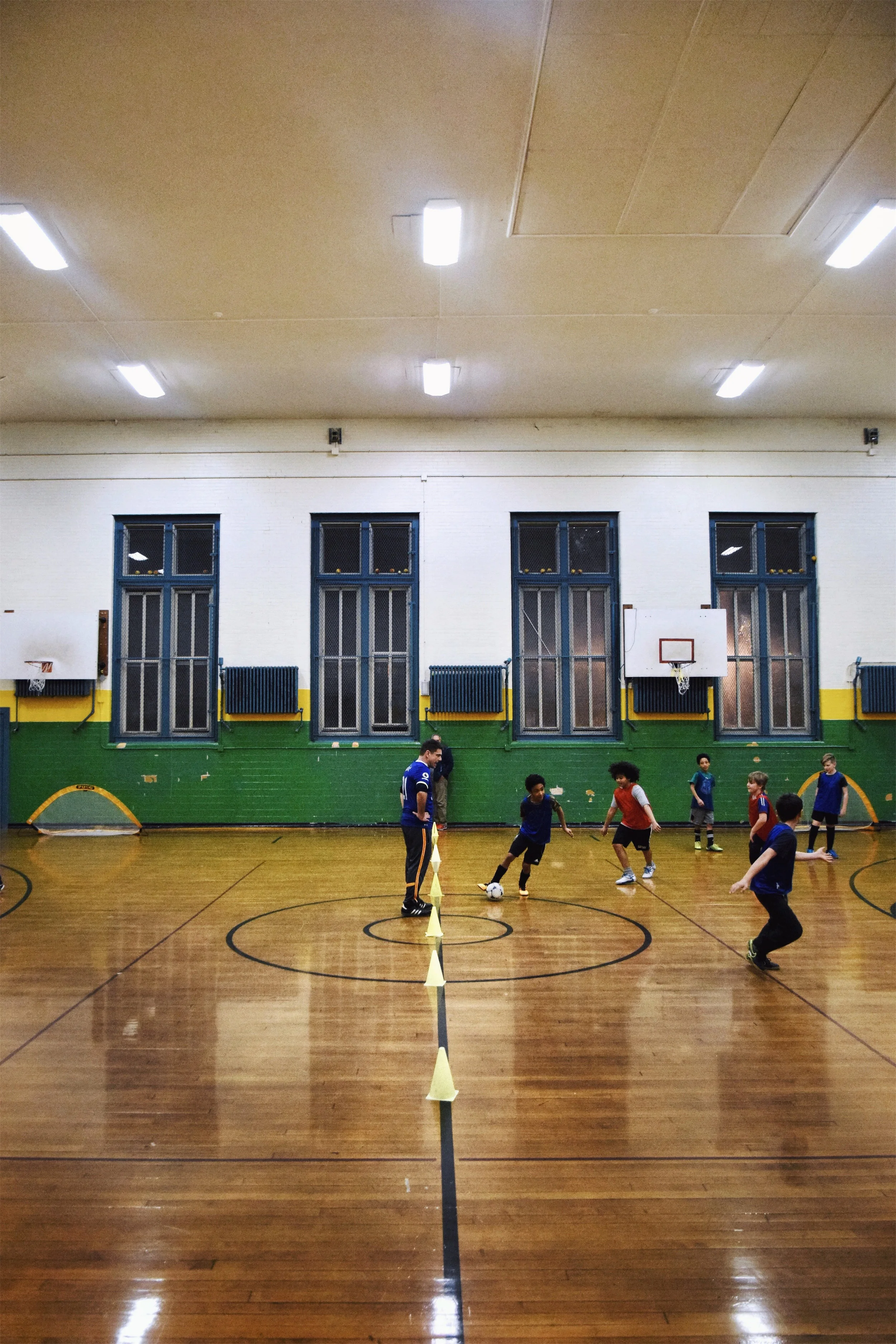A pitch for the next American pastime
Despite the U.S. Men’s National Team being kicked out in the Round of 16, the FIFA World Cup saw the most inspired and supported Team USA effort to memory. And with ESPN2 reporting nearly 900,000 viewers of the Major League Soccer (MLS) All-Star game against German international superstars Bayern Munich, it seems that soccer is America’s new sporting frontier.
Good news for the newly minted New York City Football Club: media analytics company, Horizon Media Agency is calling fútbol “the sport of America’s future,” due to their finding 57 percent of the nation’s millennial generation watched the 2014 World Cup. That’s a viewership increase of nine percent over the course of one generation. The same study found approximately a third of that 77 million strong population grew up playing the game. Figures like these suggest that the sport is becoming more ingrained in the American psyche as the years pass, and pundits, coaches, and players agree that Gen-Y is dragging soccer in the U.S. to live up to its major league status.
Soccer fans worldwide
Through the Years
It might seem puzzling as to why it’s taken the world’s “beautiful game” so long to catch on in the sports crazed USA, but Emerson College sophomore and soccer team member, Elias Romanos, thinks the country’s history of xenophobia has something to do with it. He says, “[soccer] was very foreign to people unless they got really into the sport. Unless you’re really into it, you’re less aware and you don’t have the same understanding of the game and the players.” He says the reason most people end up watching sports is due to a love of the latter two. “It’s not something that people used to grow up watching,” he continued.
However, former ESPN soccer commentator, Seamus Malin, says that America hosting the 1994 World Cup was essential to giving soccer the exposure in the country it needed to grow. “It used to be a private school game with very few exceptions,” he says. Seamus believes the sport in the U.S. used to be a game for Ivy Leaguers and Ethnic communities, for who the game is a cultural staple. The sport used to be a huge cultural leap for Americans, but, he says, “the World Cup was given to the USA with the proviso that the country start a national soccer league, and the MLS was born… A population of new Americans suddenly had soccer in their backyards.”
The MLS was born in 1993, and three years later had its inaugural season. The league is now in its 20th year, and, according to soccer news website, SoccerAmerica.com, attendance records are consistently being broken. That’s not to count the millions more across the country, and the world, who the MLS reports as tuning in weekly to watch the games.
Soccer players worldwide
The Millennial Effect
The millennial generation — defined as being born between the early 80s and the mid 90s — grew up with community soccer, something no other generation in the history of the States has had access to. According to Malin, in the suburbs, such was the popularity of youth soccer that it became almost glorified daycare for people. Everybody played.
Twenty-one year old fútbol fan from Miami, Florida, Anthony Monzon thinks his generation is the turning point for the sport. “I was brought up within a very large international community,” he says. “Being raised in that sort of environment definitely gave me a high level of exposure to soccer from a young age… I’m a firm believer digital culture was essential in giving rise to soccer in the US,” he went on. “The Internet Age may be the most significant communicational revolution to date, and living through it has given millennials more information about the world than any other generation.” Monzon believes this early exposure and more ready access to information about the world made it easier to get into soccer this side of the pond by showing all the best players in the world, week in, week out, from the comfort of local bars and armchairs.
who play soccer
A very millennial-centric platform, video games show a glimpse of soccer’s popularity among America’s rising generation. According to soccer blog, soccerly.com, FIFA (a soccer simulation game) is the most profitable video game series worldwide, with sales of $3.6 billion annually. FIFA 2015’s 2.12 million sales in the USA alone this year surpassed NBA 2K, and are fast closing on Madden NFL’s 4.1 million. And Emerson soccer team midfielder, Elias Romanos, says for a nation vastly isolated from world soccer due to time difference and culture, this is huge news.
Women and Children
Massachusetts youth soccer coach, Dean Conway, says that one of America’s core values could help the beautiful game continue to grow stateside. “America is hugely egalitarian,” he says. “While they might not be able to afford all the equipment of other American sports, kids will always be able to afford soccer… We can get them a pair of boots and give them access to a sport.” Accessibility like this, Conway explains, means that what was once viewed as glorified daycare for suburban children is now one of the easiest sports for kids to get into, stick with, and love.
In the USA (including women's)
Cameron Castleberry is one one of the best examples. “I’ve been playing for 15 years,” says the U20 US Women’s National Team member. She has seen support for the sport improve firsthand. “My team is obsessed with soccer, and here in Chapel Hill, most people are as well,” the University of North Carolina sophomore says. “I think that support is definitely showing improvement. We have superb attendance at all of our matches in the fall seasons and little girls flock around [me and my teammates] for autographs. It’s pretty cool,” she says.
World Cup commentator Malin says that women like Castleberry are one of the many reasons fútbol is gaining popularity in the States. He reckons because America was such a trailblazer for women’s soccer, the sport has an audience which crosses genders more than football, basketball, baseball, and ice hockey. He conceded that “[In ten years, soccer] won’t be up to the level of the NFL, NBA, MLB. They’ll never be surpassed. But the fan base will grow, the way it has grown involving both genders… Mothers will be encouraging their kids to go out and play, and playing with them.”
play in MLS
Slowing the Game
One slowing factor, however, may be the American quality of play. Romanos, a native of Los Angeles, California, is an Athletico Madrid fan first, LA Galaxy fan second. He says, “It’s more fun to watch a European team. The quality of the players you see, the quality of the teams, it’s more fun to watch a team who competes against the best than against relative unknowns.”
Veteran youth soccer coach Conway acknowledges the disparity in play between the USA and the rest of the world. From his experience, he says this comes from the way soccer is taught to kids. According to him, coaches focus too much on physical conditioning too young, and having big strong players who can play games each week, and could benefit from spending more time on tactics and technical play. The issue with the sport still being so young in the country, he says, is that most coaches don’t know the important intricacies of the game well enough to give the kind of suggestions that make good players great.
Castleberry agrees. “Europeans live and breathe soccer,” she says. “Brilliant touches, [ball control], and having strong technical ability is an extremely important element of their game. Here, we build the players with incredible athleticism, strength, agility, and speed, but ball handling skills are then developed and practiced afterwards. The [skill] of play of, say, Barcelona and Real Madrid — the two best teams in the world in my opinion — is unmatched here in the US.” For the most part, the importance of skill and technical excellence in game hasn’t had the chance to permeate the American sport — yet.
Conway doesn’t think this will be a permanent stumbling block. “As time goes on, coaches themselves will improve technically, and be able to better direct young players,” he says. “The MLS has already improved technically in the last 12 years in ways you couldn’t imagine,” he says. Soccer is already expanding nationwide, gaining momentum at a staggering rate, and an inevitable improvement in quality of play will only act as a catalyst for the fútbol fever currently heating the country.
To join MLS in next three years
Just Kicking Off
“The rest of the world is so ignorant to American soccer,” says World Cup commentator, Malin. “[They’ve] got their heads in the sand, and while the English and European leagues haven’t gone anywhere. America’s has evolved so much in many different ways,” he says.
One thing’s certain. Stateside soccer support is here to stay. Millennial US soccer fan, Anthony Monzon, says “there’s a great sense of pride and gratitude amongst millennial Yanks [US Soccer fans]. We’re living in the time of the true rise of soccer in the States, and we're helping build it.”
*all figures correct at time of writing, April 2015












